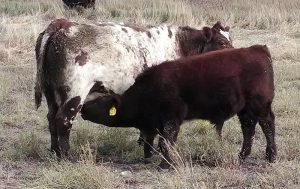Reprinted from The Register magazine.
By retired IGS Geneticist, Dr. Lauren Hyde.
Expected Progeny Difference FAQ
Q 1. How do you balance EPD selection and actual phenotypes?
Expected progeny differences (EPD) have a clear advantage over less sophisticated predictors such as raw weights and contemporary group ratios. Performance data are subject to environmental influences, such as available feed and management, and cannot be compared from one herd, or even one pasture, to another. Contemporary group ratios are more informative than actual or adjusted measurements, but they don’t take into account differences in performance from selective mating, nor do they include comparative performance data on related individuals in other herds. EPD are calculated using complex statistical models and methodology. The statistical models use all known information on a particular animal to calculate its EPD. This information includes its own performance data, such as birth, weaning, and yearling weights; records on its progeny and other relatives; and genomic data on all of these animals. Performance records are adjusted for such factors as age and sex of the animal and age of the dam prior to being evaluated. These adjustments allow performance records to be fairly compared in the analysis. In addition, genetic merit of mates is accounted for so that animals’ progeny records are not influenced by superior or inferior mates. The statistical analyses used for EPD calculation also account for the effects of environment (e.g., nutrition, climate, geographical location) that exist between herds. These environmental effects can be estimated due to the widespread use of artificial insemination (AI). Through AI, the same bull can be used in several herds throughout the world. These common sires create genetic links among herds with differing environments and serve as the foundation for large-scale genetic evaluation. For these reasons, animals with published EPD within an evaluation may be directly compared regardless of their age and origin. Finally, the genetic relationships that exist between various traits are also considered in the EPD calculations. Growth traits provide a classic example of this. Some genes affect growth only during certain stages on an animal’s life, while others affect growth in general. These genes affect two or more traits, and as a result, the traits are genetically correlated.
Q 2. What is a ratio and how useful is it in selecting animals for their genetic merit?
A ratio is the performance on an individual animal relative to the average performance for his or her contemporaries. Suppose that 10 bull calves weighed an average of 600 pounds at weaning. One calf weighed 630 pounds, so his ratio is 105, which means he is 5% heavier than his contemporaries.
Ratio = (630 ÷ 600) x 100 = 105.
Another calf weighed 570 pounds, so his ratio is 95, which is 5% lighter than the contemporary group average.
Ratio = (570 ÷ 600) x 100 = 95
Ratios can be a useful tool for within-group selection; however, they do not correct for mating bias or allow for comparisons on animals outside of the contemporary group. Use of more advanced selection tools, like EPD, provides comparisons among all animals in the evaluation with greater accuracy.
Q 3. When selecting easy-calving bulls, is it better to emphasize the calving ease EPD or the birth weight EPD?
Economically relevant traits (ERTs) are traits that directly generate revenue or incur costs in beef production systems. For a commercial cow-calf producer, dystocia (or calving difficulty) is what generates costs in a cow herd through direct losses of calves and their dams, increased labor costs, and lower reproductive rates among cows that have experienced dystocia. Calving ease is an ERT.
Birth weight, on the other hand, is an indicator trait. It provides some information on calving ease, but by itself, doesn’t directly generate revenue or incur costs independent of calving ease. Based on results from several research studies, birth weight accounts for only 55 to 60 percent of the genetic variation in calving ease.
This means that selection for reduced birth weight alone won’t improve calving ease as much as selecting directly on calving ease. In addition, birth weight is strongly genetically correlated with other growth traits, so reduction in birth weight is associated with lighter weights at weaning and yearling.
Q 4. Why does my bull have a high birth weight EPD but his actual birth weight is low?
Birth weight EPDs are computed using not only the birth weight of the bull but also his own weaning and yearling weights; the birth, weaning, and yearling weights on his calves and other relatives; and the genomic data on all these animals. Weights are adjusted for known environmental effects, like sex of calf and age of dam, that do not have a genetic component, and therefore, are not transmitted from parent to offspring. For example, all things being equal, a heifer calf will weigh less than a bull calf. A bull born to a heifer will weigh less than a bull born to a mature cow. A bull born during a drought will weigh less than a bull born during a time of abundance. Because of these environmental effects and all the other data used to compute an EPD, actual birth weight isn’t a particularly accurate measurement of a bull’s progeny’s birth weight. A bull with a low birth weight can have a high birth weight EPD and vice versa.
Q 5. Why should I trust EPD when I know that some breeders turn in fabricated data?
Genetic evaluation relies primarily on field data collected by many different breeders with varying knowledge and interest in the principles of animal breeding and genetics. Therefore, these data are subject to error, intentional or not.
EPD are based to a large extent on the performance of relatives, so it is imperative that the pedigrees of all animals are correct. However, misidentification of parents is not unusual — even in humans! Parentage testing through DNA has been very useful in identifying pedigree errors and has been invaluable to high-quality genetic evaluation.
On the performance side, some breeders deliberately falsify records. They want to make their animals look better than they really are. There also are breeders who only report data on their “good” animals. More frequently, breeders guess animal performance rather than carefully measure it. Data like these can cause bias in the evaluation; however, there are statistical procedures that can identify and filter out biased data. In addition, bias due to reporting errors is generally short-lived. As soon as an animal has progeny, especially in different herds, pedigree and performance errors of its own and of its collateral relatives are of little consequence.
Q 6. Why should I use EPD when they change from one evaluation to the next?
EPD change over time as more and more data are included in successive evaluations. But change is not necessarily a bad thing. With more data comes improved accuracy, and higher accuracy means the smaller the amount of possible change in future evaluations. In other words, EPD on a high-accuracy animal will change very little in future evaluations compared to those on a low accuracy animal. Higher accuracy leads to less risky selection decisions. With EPD updated on a weekly basis through the IGS Multi-breed Genetic Evaluation powered by BOLT, ASA provides the most accurate, most rapidly available tools to optimize selection decisions.
Q 7. How can I improve my bull’s EPDs?
Although you can’t make your bull’s EPD better, you can improve the accuracy of those EPD through data collection. Collect performance data on the bull and all of his contemporaries. Get all of them DNA tested. If possible, ensure that his calves’ data are reported. Although his EPDs may move in an unfavorable direction, more data improves accuracy, and higher accuracy leads to less risky selection decisions.

Thermal Energy as a Calf with Dam
